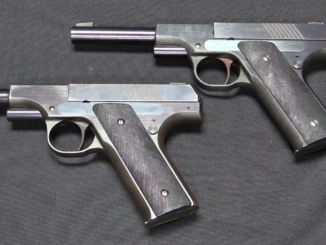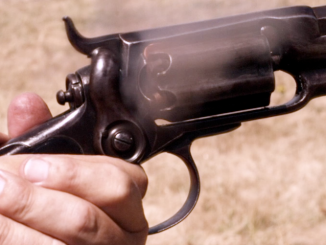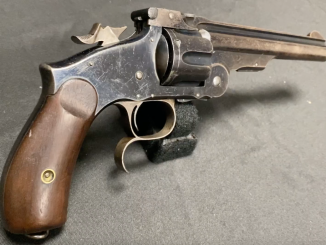This rifle sold (for some reason) for $10,925 at Rock Island on December 2, 2018.
When the USMC adopted the M1 Garand in 1942, they decided they would like to have a new semiautomatic training rifle in .22 rimfire to go along with it. Eugene Reising, working for Harrington & Richardson, promptly produced a semiauto .22 LR version of his military submachine gun to fulfill that role, designated the Model 65. This rifle had a stock and barrel sized to duplicate the handling of the M1, and a nice aperture sight as well. By 1945, between 6,000 and 10,000 had been sold to the military, and total sales would reach about 18,500. After the war, H&R attempted to make the rifle more popular on the commercial market as the Leatherneck, Model 150, and Model 151, but sales were tepid.
In 1958, the USMC contracted for another quantity of the rifles, as they were adopting the M14 at that time. Several minor changes were made to the rifle, and one significant one – the safety was changed from a Reising type lever to an M1/M14 type safety located in the front of the trigger guard. This new pattern was designated the MC-58, and about 3500 were purchased by the Corps in 1958 and 1959. Serial numbers on the MC-58 rifles began at 6,000 and went to about 9,500, suggesting that 6,000 Model 65 rifles were originally purchased by the Marines during World War Two.




Pretty sweet .22 rifle, if a little heavy. Does anyone know how accurate these were? The heavy barrel suggests accuracy should be pretty good, but how does it compare to for example the Ruger 10/22?
Damn, that looks like it would be fun to shoot.
This should be no surprise considering he was ranking competitive target shooter.
is: “(…)he(…)”
should be: “(…)Eugene Reising(…)”
There are some clever elements on it. That charging handle in particular is break-thru and practical solution. What it lacks however to be attractive, is civilian finish.
It was quite unluckily for Reising for him to become associated with sub-machine gun with “unreliable” fame. To be honest, it was not only his fault, as it was rushed in service and it seems that manual lacked important phrase swapping parts between examples is strictly prohibited and was faced with very adverse environment (humidity and dirt), while unfit for such service Reising sub-machine gun was used by several years by police in U.S., so it looks that it was quite reliable when keep clean. Also was lighter and more accurate than Thompson sub-machine gun.
Beyond sub-machine gun (and derivatives) Reising also designed .22 rim-fire automatic pistol: https://americanhandgunner.com/exclusive-web-extra-the-reising-22-semi-auto-pistol/
True, the issue was that the top brass tended to toss out the user manuals on the grounds that nobody would read them anyway. It doesn’t help if half your troops are illiterate…
I have an MC-58 that is still new in the box as it was packed away in March of 1959. The rifle, Boyt leather sling, two magazines,spare during pin and extractor are listed on the inventory tag on the box.
The Reising was a hot-house orchid of a weapon. A weapon that has little interchangibility of parts and that can’t be used under field conditions is by definition a POS that reeks. Or should the U.S. and Japan have come to a gentlemen’s agreement to have warred only in temperate climates on clear days with no blowing dust?
I grew up with one of these. It was heavy for a 22 but the one we had was very accurate.